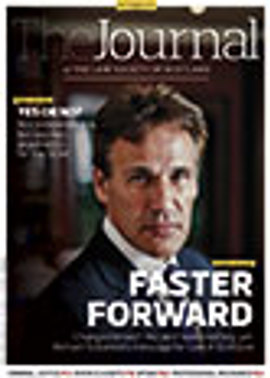Petrodel: could it happen here?

The judgment of the Supreme Court in Prest v Petrodel Resources Ltd [2013] UKSC 34 was eagerly anticipated by family and corporate lawyers alike. On 12 June 2013, the court unanimously overturned the decision of the Court of Appeal and ruled against a wealthy oil tycoon, Michael Prest, ordering that seven properties vested in Petrodel Resources Ltd be transferred to his former wife, Yasmin Prest, in part settlement of a £17.5 million award in her favour. The decision was justified primarily on the basis that Mr Prest was beneficial owner of the companies which were, the Supreme Court held, holding the properties on resulting trust for him.
On the face of it, the notion in Prest that assets held by a third party could comprise resources for the purpose of financial provision on divorce is relatively foreign in Scottish divorce law, contradicting the overarching principle that matrimonial property should be restricted to the property acquired or generated during the marriage as a result of the parties’ joint efforts. This article considers whether the approach in Prest is really that alien in Scots divorce law.
History in the making
Mr and Mrs Prest were married for 15 years, during which time Mr Prest accumulated substantial wealth as an oil trader. He owned and controlled a number of companies, including several registered in the Isle of Man, which were part of the Petrodel Group. The companies owned a number of properties.
Mrs Prest’s petition for divorce joined seven companies in the Petrodel Group to her application. Moylan J considered the nature and extent of Mr Prest’s wealth, specifically his interest in the companies, and whether it was permissible for the court to make orders in relation to the properties held in the companies’ names. The key issue was whether the properties were caught by s 24(1)(a) of the Matrimonial Causes Act 1973 (“MCA 1973”), which provides that a court may order the transfer of property where one party is “entitled” to the property in question “either in possession or reversion”.
Moylan J determined that the company assets were quite clearly operated and controlled for the benefit of Mr Prest and his immediate family. As “both the effective owner and controller of the whole of the Petrodel corporate structure”, it followed that the properties held by three of the companies could be transferred to Mrs Prest in part settlement of her award. Mr Prest and the three companies appealed.
Mr Prest’s appeal was dismissed at a preliminary stage as he failed to comply with orders by the Court of Appeal. However, by a 2-1 majority, the companies’ appeal was successful. Applying strict company law principles, the court concluded that the judge had erred by ordering the transfer. His decision contravened historic case law that a duly incorporated company is a separate legal entity distinct from those who incorporate it, with separate rights and liabilities. In response to Mrs Prest’s alternative argument that the companies held the properties on trust for Mr Prest, the Lords Justices considered that this was “not only difficult, but impossible”.
The Supreme Court allowed Mrs Prest’s appeal and restored the High Court’s decision.
An English peculiarity?
Although the Supreme Court’s approach may initially appear unfamiliar to Scots family lawyers, it is similar to that adopted by Lord Brodie in AB v CD and Bank of Scotland Trust Company (International) Ltd [2006] CSOH 200.
AB v CD concerned the treatment of offshore trust assets, the Mergie Trust, in the context of a Scottish divorce, and whether or not these assets constituted matrimonial property “belonging to” the husband in terms of s 10(4) of the Family Law (Scotland) Act 1985 (“FLSA 1985”). The trust assets were valued in excess of £1,000,000, and included Mergie House, valued at £450,000, cash and unquoted investments.
The marriage broke down in 1999, but the matter did not come before Lord Brodie for proof until 1 December 2006. Mergie House was initially jointly owned by the parties, but was disponed to the husband following the parties’ temporary separation. In 1995, he disponed it to the Pirunico Trustees (Jersey) Ltd, which disponed it to the Mergie Trust in 1996. Mergie House remained an asset of the trust until it was gratuitously disponed to Sherlock Management Inc, a company incorporated in the British Virgin Islands, in 2004.
The Mergie Trust was discretionary in nature, no single beneficiary having any fixed interest in its assets. However, Lord Brodie remarked that the trust affairs were conducted with a degree of informality, and it was apparent that Sherlock Management Inc was controlled by the husband, who was introduced as a potential beneficiary of the trust in 2005. Concluding that the husband was beneficially entitled to the trust assets, Lord Brodie commented that “the Mergie Trust… was no more than a means of managing assets for the benefit of [the husband]”. For that reason, Lord Brodie was minded to treat the trust assets as matrimonial property.
What, therefore, to make of the approach adopted by the Scottish and English courts in AB v CD and Prest? The most significant points for practitioners to take from the Supreme Court judgment are as follows.
Piercing the corporate veil?
Contrary to a number of media reports, the corporate veil in Prest was not pierced, Lord Sumption observing that it would only be appropriate to do so in exceptional cases, where no alternative remedy was available and to prevent the abuse of corporate legal personality. This was not, he concluded, the case in Prest.
Acknowledging, however, that there are limited circumstances where the corporate veil might be pierced, the Supreme Court relied on the principles of “evasion” and “concealment”, suggesting that the court may be prepared to look behind the façade to identify the true nature of the transaction where the company has been interposed to conceal an impropriety, or where an individual deliberately seeks to evade an existing legal obligation by interposing a company or corporate structure under his control.
Crucially, in Prest, although the husband’s conduct during the proceedings had been morally questionable, there was no evidence that the companies were set up deliberately to avoid existing obligations. Rather, they were established as a legitimate means of wealth and tax planning. Accordingly, there was no justification for piercing the corporate veil.
Although this specific matter has not been considered by the Scottish courts, it is suggested that they would be unlikely to deviate from the Supreme Court’s approach, and would similarly be inclined to uphold the separate identity of a company. Provided that a corporate structure is established for legitimate reasons, rather than to escape legal obligations on divorce, it should follow that its assets are subject to and protected by fundamental principles of company law.
Trust assets and beneficial ownership
Ultimately, the success of Mrs Prest’s appeal turned on the Supreme Court’s interpretation of the underlying ownership of the properties, which had been purchased by Mr Prest using his own money.
While the court was satisfied that Mr Prest had not deliberately sought to evade his obligations on divorce, Lord Sumption criticised his “persistent obstruction, obfuscation and deceit and [his] contumelious refusal to comply with rules of court and specific orders”. He concluded that the obvious inference from Mr Prest’s misconduct was that the companies were merely trustees who held the properties for him as beneficial owner, Mr Prest using the companies’ resources as a “money box” for his personal benefit. The analogy of Mergie Trust as the husband’s “piggy bank” was also propounded by the wife in AB v CD.
Although the Supreme Court’s analysis may have surprised many English practitioners, it is clear that the Scottish court in AB v CD demonstrated its willingness to rely on principles of trust law to justify its decision where a strict application of the legislation would not permit a just result.
Transferability of assets
The Supreme Court also touched on the restrictions on the transferability of third party assets on divorce under MCA 1973, commenting that there was nothing in the legislation “to indicate that the legislature intended to authorise the transfer by one party to the marriage to the other of property which was not his to transfer”.
It is also difficult to envisage circumstances where the FLSA 1985 would permit the Scottish courts to order the transfer of third party assets on divorce. Rather, the case law indicates that where the Scottish courts are willing to consider third party assets as a resource, they will be more inclined to redress any imbalance by awarding a capital sum as opposed to a property transfer order.
Lessons to be learnt?
The decision in Prest has been hailed as a victory for the wives of wealthy business owners, but its practical implications for Scots family lawyers may not be as far-reaching or radical as initially suggested. The Supreme Court did not pierce the corporate veil. Rather, the decision was based on the specific circumstances, the court securing a just and equitable outcome for Mrs Prest by adopting a creative interpretation of established principles of trust law, while simultaneously upholding the fundamental principles of corporate law.
Following Prest, the potential for litigation in divorce cases over the treatment of third party assets remains in both jurisdictions. Each case will turn on its own facts and circumstances, and it does not automatically follow that corporate or trust assets will be beyond the reach of a spouse. The Scottish and English case law suggests that the outcome will ultimately depend on various factors, including the good faith and conduct of the parties, the transparency and legitimacy of the corporate or trust structure in dispute, and its underlying beneficial ownership structure.
Provided assets are transferred to a company or trust for legitimate and conventional wealth and tax planning reasons, these should remain protected against claims for financial provision. However, where the entity has been established merely to conceal the intended or actual beneficial ownership of the assets with a view to circumventing obligations, the English and Scottish courts will seemingly be prepared to look behind the façade, in order to ensure that justice and common sense prevail.
In this issue
- Scotland: a patently obvious choice?
- Bringing order to family law
- Third party rights: behind the times
- Judicial review: closer to the surface
- A time for talent spotting
- Fixing fixed equipment (full version)
- Reading for pleasure
- Book reviews
- Profile
- President's column
- Moving up the gears
- Justice redefined
- Sep rep: decision time
- Petrodel: could it happen here?
- Clicks forward
- Cover lines
- Family time
- Fixing fixed equipment
- Rights undone
- Directors: not in name only
- Not quite joined up
- Heritage disowned
- Time to start growing your own?
- Are you keen to be mentored?
- LBTT: in with the new
- How not to win business: a guide for professionals
- Ask Ash
- Forum is place to flag up problems
- Scottish Barony Register fee rise
- From the Brussels office
- Law reform roundup
- Diary of an innocent in-houser






